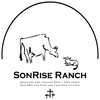The first 80 years resulted in only a few feet of erosion. The next forty have decimated the landscape. The reason - simple... our capacity to feed cattle (hay and otherwise) has increased since the 1970's dramatically.
We can now feed animals on land that was never intended to support them at the stock density or stocking rate we currently can accommodate them due to modern technology.
The first conclusion we must come to terms with is that the ecosystem we are surrounded by is not the original one given to us by the natives (or taken, rather) - once the settlers came to the west. History tells us that the grasslands of the western plains (our Ranch included) had grasses so thick that you could tie them in a knot... while you were on your horse.
Let that sink in for a bit...
"while you were on your horse"
If you've followed us, you know that the answer to our carbon problems is grass - not soybeans, not corn, not "fuel alternatives" but perennial grasses - why? Because the root system on perennials stores atmospheric carbon. Tons of it - literally, metric Tons of Carbon per acre!
The more roots, the more Carbon can be stored. The problem is the roots - they follow the "one-third, two-thirds" rule - meaning that for each third of biomass above ground, two-thirds of roots exist below ground. So, think with me, if the early Europeans wrote letters home saying they could tie grass in knots (its was dense and thick) while sitting a saddled horse, then we are talking root systems that were 12 feet deep!
Wow! Talk about Carbon Sequestration - these grasslands were Carbon Negative before Carbon Negative was cool.
So what happened to them?
We did...
But, here is the good news. We know how to get them back - and we know that, historically, they were present here on our lands, so it is possible to restore them (seed beds stay present for over 100 years in dormancy). We just have to tilt the ecosystem back in the favor (and manage animals - remember there are no ecosystems void of animal or insect presence without human interaction causing that void) of these ancient perennial grasses.
How do we do this?
Good question - here is a video of just one of the many steps required to make this happen.
1. Ground Cover (biomass - old hay, wood chips, old-growth grass from last year)
2. Herd Impact (all systems have animals - only we can alter their behavior)
3. Rest (do not walk, graze or use the land)
4. Graze (very high density - lots of hoof lbs. per acre, very short period of time)
5. Rest
6. Graze
7. Repeat
Is this not the solution we are looking for?

 RSS Feed
RSS Feed